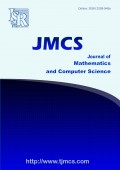Applications of Opls Statistical Method in Medicine
-
5131
Downloads
-
5387
Views
Authors
Kianoush Fathi Vajargah
- Department of Statistics, Islamic Azad University, North branch, Tehran, Iran.
Robabe Mehdizadeh
- Department of Statistics, Islamic Azad University, North branch, Tehran, Iran.
Homayoun Sadeghi-bazargani
- Department of Statistics and Epidemiology, Tabriz University of Medical Sciences, Tabriz, Iran.
Abstract
Studies related to prognosis in medicine result in a large volume of variables if clinical and laboratory variables are simultaneously accompanied with new imaging techniques; this issue causes problems for classical statistical methods such as logistic and linear regression. Among these cases, emergence of multicollinearity or close linear correlation between regression variables when the number of regression variables is high can be pointed out. Emergence of multicollinearity is inappropriate for ordinary least squares of regression model. PLS is a well-known method for connecting two X and Y data matrices using a multicollinearity model. OPLS is the product of a change which has occurred on PLS method in recent years. Considering application problems of linear regression method, applying an alternative method is a requirement. Using OPLS method can reduce model complexity and develop its power.
Share and Cite
ISRP Style
Kianoush Fathi Vajargah, Robabe Mehdizadeh, Homayoun Sadeghi-bazargani, Applications of Opls Statistical Method in Medicine, Journal of Mathematics and Computer Science, 8 (2014), no. 4, 411-422
AMA Style
Vajargah Kianoush Fathi, Mehdizadeh Robabe, Sadeghi-bazargani Homayoun, Applications of Opls Statistical Method in Medicine. J Math Comput SCI-JM. (2014); 8(4):411-422
Chicago/Turabian Style
Vajargah, Kianoush Fathi, Mehdizadeh, Robabe, Sadeghi-bazargani, Homayoun. "Applications of Opls Statistical Method in Medicine." Journal of Mathematics and Computer Science, 8, no. 4 (2014): 411-422
Keywords
- Medical studies
- linear regression
- PLS
- OPLS
MSC
References
-
[1]
DC. Montgomery, EA. Peck , , Translated by: Razavi Parisei SA. Statistics: Introduction to Linear Regression Analysis. 1st ed. Shahid Bahonar University of Kerman Publications, (1953), 471-485,501-503
-
[2]
RA. Johnson, DW. Wichern , , Translated by: Niroomand HA. Statistics: Applied Multivariate Statistical Analysis. 2nd ed. Mashhad Ferdowsi University Press, (Persian). , (1942), 431-432
-
[3]
A. R. McIntosh, NJ. Lobaugh , Partial least squares analysis of neuroimaging data: applications and advances, NeuroImage , 23 (2004), S250–S263.
-
[4]
H. Sadeghi Bazargani , Epidemiology and Statistical Modeling in Burn Injuries, Thesis submitted for epidemiology PhD degree, Karolinska Institutet, Sweden (2010)
-
[5]
T. Majidi Parsa , Partial least squares regression and its applications, Thesis submitted for Statistics Msc degree, Islamic Azad University Tehran North Branch (2008)
-
[6]
H. Charles, R. Disya , Ultrasound and cerebral vascular disease, In: Toole JF, editor. Cerebrovascular disease, 5th ed. Philadelphia, Lippincott Williams & Wilkins, (1998), 83-128.
-
[7]
H. Abdi , Partial least squares regression and projection on latent structure regression (PLS Regression), Wiley & Sons, Inc. WIREs Comp Stat (2010)
-
[8]
J. Gabrielsson, H. Jonsson, C. Airiau, B. Schmidt, R. Escott, J. Trygg , The OPLS methodology for analysis of multi-block batch process data, J Chemometrics , 20 (2006), 362-369.
-
[9]
J. Gabrielsson, H. Jonsson, C. Airiau, B. Schmidt, R. Escott, J. Trygg , OPLS methodology for analysis of pre-processing effects on spectroscopic data, Chemometrics and Intelligent Laboratory Systems, 84 (2006), 153-158.
-
[10]
M. Jalali-Heravi, H. Ebrahimi-Najafabadi, A. Khodabandehloo , Use of Kernel Orthogonal Projection to Latent Structure in Modeling of Retention Indices of Pesticides, QSAR Comb Sci , 28 (2009), 1432-1441.
-
[11]
L. Eriksson, E. Johansson, N. Wold, J. Trygg, C. Wikstrom, S. Wold , Multi- and Megavariate data analysis: Advanced applications and method extensions, 1st ed. Umea, Umetrics AB (2006)
-
[12]
J. Trygg, S. Wold , Orthogonal projections to latent structures (O-PLS), J Chemometrics , 16 (2002), 119-128.
-
[13]
M. Bylesjo, M. Rantalainen, O. Cloarec, JK. Nicholson, E. Holmes, J. Trygg , OPLS discriminant analysis: Combining the strengths of PLSDA and SIMCA classification, J Chemometr , 20(8-10) (2006), 341-351.
-
[14]
H. Sadeghi-Bazargani, SI. Bangdiwala, K. Mohammad, H. Maghsoudi, R. Mohammadi , Compared application of the new OPLS-DA statistical model versus partial least squares regression to manage large numbers of variables in an injury case-control study, Scientific Research and Essays , 6(20) (2011), 4369-4377.
-
[15]
H. Charles, R. Disya , Ultrasound and cerebral vascular disease, In: Toole JF, editor. Cerebrovascular disease. 5th ed. Philadelphia, Lippincott Williams & Wilkins, (1998), 83-128.
-
[16]
K. Rajamany, M. Gorman , Transcranial doppler in stroke, Biomed Pharamacother , 55 (2001), 247-57.
-
[17]
LR. Wechsler , Cerebrovascular diseases, In: Babikian VL, Wechsler LR, editors. Transcranial doppler ultrasonography. 2nd ed. USA, Butterworth-Heinemann, (1999), 91-108.
-
[18]
R. Mehdizadeh Esfanjani , Comparison of PLS and OPLS methods in controlling the variety of variables, Example: A Sample in TCD. Thesis submitted for Statistics Msc degree,, Islamic Azad University Tehran North Branch (2011)
-
[19]
IR. Dohoo, C. Ducrot, C. Fourichon, A. Donald, D. Hurnik , An overview of techniques for dealing with large numbers of independent variables in epidemiologic studies, Prev Vet Med , 29(3) (1997), 221-239.
-
[20]
S. Wold, H. Antti, F. Lindgren, J. Ohman , Orthogonal signal correction of near-infrared spectra, Chemometrics Intell Lab Syst , 44 (1998), 175-185.
-
[21]
M. Bagheri, M. Valipour, V. Amin, The Bankruptcy Prediction in Tehran share holding using Neural Network and it's Comparison with Logistic Regression, , 5(3) (2012), 219- 228
-
[22]
A. Arjmandzadeh, S. Effati, Interval Support Vector Machine in Regression Analysis, , 2(3) (2011), 565- 571
-
[23]
A. H. Hadjahmadi, T. J. Askari, A Decision Support System for Parkinson's Disease Diagnosis using Classification and Regression Tree, , 4(2) (2012), 257 – 263

